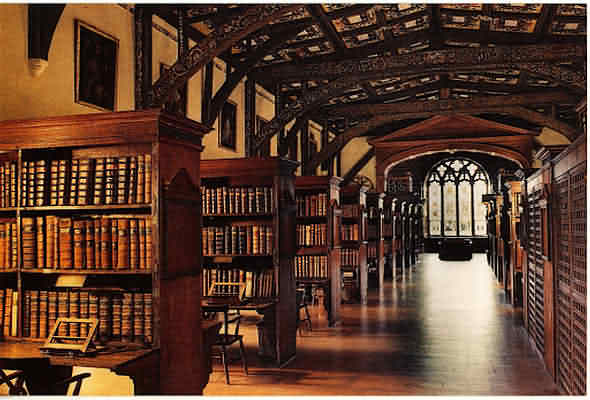Oxford is home to 38 self-governing graduate and undergraduate colleges with their own libraries; these are federated under Oxford University, and the Bodleian serves as the central library.
The Bodleian is also a deposit library, meaning that it receives copies of every book published in Britain (much like the Library of Congress in the US). The Bodleian receives two copies of each book (though it doesn't necessarily accept every book): one copy can be lent out and the other is kept in the library as read-only.
The tour started in the Divinity School room, first built in the 1400s as a theology lecture hall. (Harry Potter fans may also recognize the Eastern end of the hall as the Hogwarts infirmary.)
It's a beautiful room in late English Gothic style, with ornate carvings along the walls and ceiling. The designer even had is initials carved in various places in the ceiling (W.O. for William Orchard).
Next, we went into the Convocation House, where Masters of Arts would meet to make decisions about the college. Now, it is only used when a new chancellor or professor of poetry is elected.
The Chancellor's Court served as the College's own civil and criminal court, separate from the town's court. Students at the time were aged 14 to 18, so this was an attempt to settle problems within school walls. Oscar Wilde answered for unpaid debts here. Having two courts in one town made for some tension, understandably, so the Court finally relinquished its powers in the 1960s.
We weren't allowed to take pictures of the second floor, and we had to be super quiet so as not to disturb the readers (our tour guide spoke to us softly through headsets), but it was a librarian's fantasy: floor-to-ceiling bookcases, a wood-paneled ceiling sporting Oxford coats of arms, and a gallery providing access to the upper shelves. The books used to be chained by their front covers to the shelves, so that readers could not remove them from the library. Readers would have to sit at desks in front of the shelves and read them there.

Photo taken from: http://www.curveworkplaces.co.uk/office-furniture/bodleian-library-creates-bespoke-chair-competition/
The center of this space, called the Duke Humphrey Library, is considered the birthplace of the Bodleian. It used to contain more than 280 handwritten manuscripts collected and donated by Humphrey, Duke of Gloucester (the younger brother of King Henry V). The age of print and the Reformation made this collection short-lived (the manuscripts were considered part of the Roman Catholic order) and the collection was disposed of. Only 47 manuscripts remain, 5 of them are in the Bodleian. Talk about a case of weeding gone wrong.

Photo taken from: http://www.cotswolds.info/places/oxford/bodleian-library.shtml
The chance to visit Oxford and the Bodleian was a key reason I applied for this study abroad program, and it did not disappoint. To see such a beautiful, historic place still standing and in use is a magical thing.
Oh, one more thing: here's a cool link to the sounds of the Bodleian, a live audio feed of the Bodleian's various libraries and reading rooms.






No comments:
Post a Comment